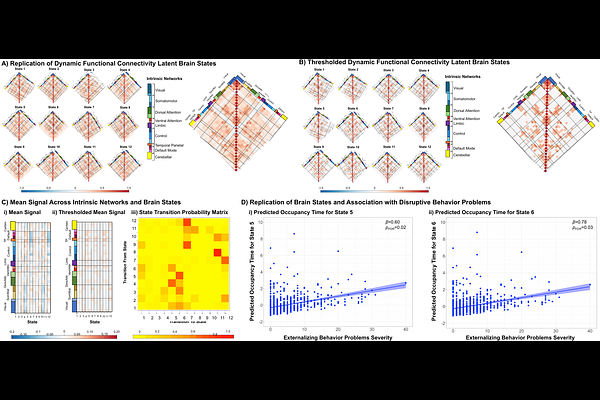Dynamic Resting-State Network Markers of Disruptive Behavior Problems in Youth

Dynamic Resting-State Network Markers of Disruptive Behavior Problems in Youth
Shappell, H.; Liu, Z.; Khodaei, M.; He, G.; Gee, D.; Lindquist, M.; Sukhodolsky, D. G.; McCarthy, G.; Ibrahim, K.
AbstractBackground: Childhood disruptive behavior problems are linked to aberrant integrity within large-scale cognitive control networks. However, it is unclear if transitory or dynamic variation in the functional brain architecture is a marker of disruptive behavior problems. The current study tested whether functional connectivity across dynamic networks is distinctly associated with the transdiagnostic symptom domain of disruptive behavior problems in children. Methods: Participants were aged 9-10 years from the Adolescent Brain Cognitive Development (ABCD) Study, who completed resting-state fMRI (N=877). We employed a dynamic connectivity approach leveraging a hidden semi-Markov model (HSMM) to identify transient properties of brain networks and states. Models estimated the time spent in each state (occupancy time) and the number of consecutive timepoints in a state (dwell time) for each participant. Linear regression models were utilized to identify distinct associations between dynamic properties (occupancy and sojourn times) and severity of disruptive behavior problems, accounting for other commonly co-occurring symptoms. Results: Dynamic network markers of disruptive behavior problems included increased time in network states characterized by globally aberrant connectivity patterns in circuitry involved in cognitive control including frontoparietal and dorsal attention networks. Replication of findings was found in a held-out sample of resting-state fMRI runs in which greater severity of disruptive behavior problems was uniquely linked to greater occupancy time in similarly characterized brain states. Conclusion: Transdiagnostic, dynamic resting-state markers of disruptive behavior problems in youth may assist in the development of brain-based biomarkers for monitoring treatment outcomes, assessing circuit target engagement and informing clinical decisions.